Let’s make one thing crystal clear: a dirty wound can kill you faster than a bullet. Not immediately, no. But give it a couple days, and suddenly you’re in a fever dream, convulsing in a ditch, wondering why you didn’t just take the extra 3 minutes to clean it properly.
This isn’t a joke, and it’s not a luxury skill. If you think modern medicine will always be there to patch you up, you’re already halfway dead. In a grid-down scenario or even just a weekend hike gone wrong, knowing how to clean a wound can mean the difference between healing and hemorrhaging. Let’s get serious.
Why Cleaning a Wound Actually Matters
Let’s cut through the Hollywood nonsense. You don’t just pour whiskey on it, grunt like Rambo, and move on.
An unclean wound is an open invitation to bacteria, viruses, and God knows what else. Staph, tetanus, necrotizing fasciitis (look that one up if you’re brave)—they love a warm, moist, bloody environment.
And here’s the real kicker: the first few minutes after an injury are the most critical. What you do—or don’t do—right after you get cut can set the stage for infection, permanent damage, or even sepsis. Think hospitals will be around forever? Think again. When society cracks, you are the emergency room.
Step-by-Step: How To Clean a Wound (The Right Way)
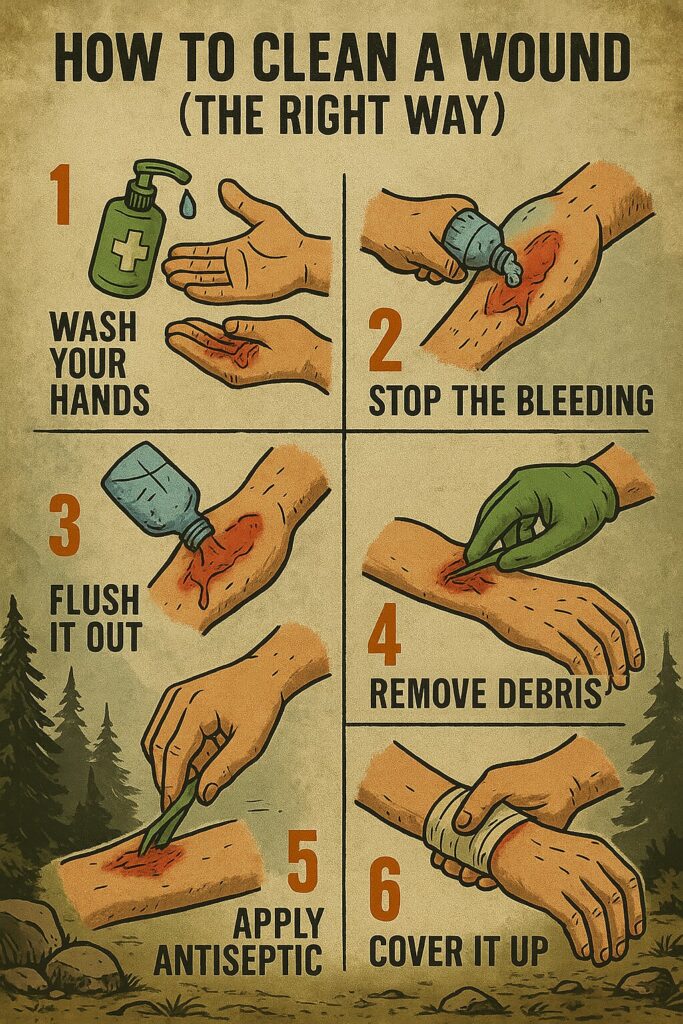 Whether it’s a slice, puncture, scrape, or gash—here’s what to do immediately:
Whether it’s a slice, puncture, scrape, or gash—here’s what to do immediately:
-
Wash Your Hands
Yes, before touching the wound. Use clean water, soap, or alcohol-based sanitizer. If you’re out in the field, wear gloves if you have them.
No gloves? Wrap your hands in plastic, use a bandana, or sanitize as best you can. Cross-contamination is real—and dangerous. You’re not just cleaning the wound, you’re preventing yourself from becoming the source of infection.
-
Stop the Bleeding
Apply firm pressure with a clean cloth, gauze, or even your shirt if you’re desperate. Elevate the wound if possible.
If bleeding doesn’t stop after 10 minutes of firm pressure, or it’s spurting (arterial), you’ve got a bigger problem—this is life-threatening. Apply a tourniquet if necessary, and get help fast if any’s available.
-
Flush It Out
This is critical. Irrigate the wound using:
- Clean water (boiled and cooled if needed)
- Saline solution (store-bought or homemade: 1 tsp salt in 2 cups boiled water)
- Syringe or water bottle nozzle for pressure
The idea here is pressure. Don’t just pour water lazily over it—get in there. You’re trying to blast out dirt, bacteria, and foreign material, not give it a bath. If it hurts, good. That means you’re doing it right.
-
Remove Debris
Use sterilized tweezers to remove dirt, glass, or splinters. If you can’t get it all out safely, stop and reassess.
Don’t go digging blindly. If it’s too deep or near vital areas (eyes, joints, neck), and you have access to professional help—use it. Otherwise, keep the wound as clean as you can and monitor obsessively for infection.
-
Apply Antiseptic
Betadine, iodine, or antibiotic ointment like Neosporin works. Don’t overdo it—just a thin layer.
Natural options like honey or tea tree oil can help in a pinch, but don’t play herbalist unless you know what you’re doing. Infection moves fast, and your window to act is short.
-
Cover It Up
Use sterile gauze and a breathable bandage. Change daily or whenever it’s wet or dirty. Monitor for signs of infection.
Signs include increased pain, redness, swelling, warmth, and any yellow or green discharge. If red streaks appear running from the wound—that’s blood poisoning. You’re on the clock now.
Make sure to always have a good first aid kit on you since this can save your life. You can read what you need to put in it in this article.
How To Clean a Deep Wound
Here’s where things get dicey.
A deep wound is not your average scrape. We’re talking exposed tissue, punctures, or anything that goes beyond the skin and fat layer.
Key differences:
- Don’t close it immediately. You trap bacteria inside, and you might as well be embalming yourself.
- Irrigate aggressively. Use more water, more pressure, more time.
- Watch for infection like your life depends on it: swelling, redness, pus, fever, red streaks. If you see these, infection is spreading.
If bleeding is controlled and debris removed, leave the wound open to drain. Keep it covered with moist gauze (wet-to-dry dressings) to help it heal from the inside out. Rushing to seal a dirty wound is how you turn a minor injury into a death sentence.
Pain management is part of this too. You don’t want someone passing out from shock. OTC meds like ibuprofen can help reduce inflammation—but never give aspirin if there’s a lot of bleeding. That thins the blood and makes things worse.
How To Clean a Dog’s Wound (Because They’d Do It For You)
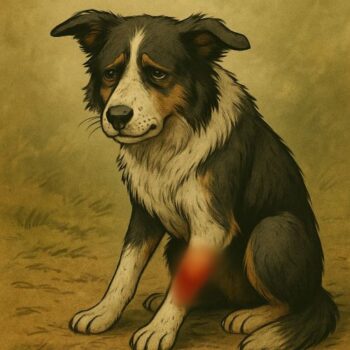 Let’s not forget about our best friends. In a world gone sideways, your dog isn’t just a pet—they’re family, security, and early warning system rolled into one.
Let’s not forget about our best friends. In a world gone sideways, your dog isn’t just a pet—they’re family, security, and early warning system rolled into one.
Here’s how to take care of them when the vet’s office is just a memory:
-
Muzzle First (Yes, Even Sweet Fluffy)
Pain makes dogs unpredictable. Better safe than bitten.
Even the gentlest dog can snap when in pain. Use a cloth, bandana, or your belt as a makeshift muzzle if needed. It’s not cruelty—it’s control.
-
Clean With Saline or Water
Same rules apply: no hydrogen peroxide unless diluted (1 part to 3 parts water, max). No alcohol. No human ointments unless approved by a vet.
Dogs lick their wounds instinctively, which can reopen or infect them. You’ll need to be vigilant, and in some cases, create barriers or use cones to prevent them from sabotaging your efforts.
-
Clip the Fur Around the Wound
Use scissors or a razor if needed. You want visibility and airflow.
Matted fur traps bacteria and hides infection. You’re not grooming for a show—you’re clearing a battlefield. Get a clean view and keep that area dry and breathable.
-
Apply Dog-Safe Antiseptic
Vet-prescribed is ideal. If not, betadine diluted with water works in a pinch.
You can also use chlorhexidine (at 0.05% concentration) if available. Avoid essential oils and random internet remedies—what works on humans can be toxic to dogs.
-
Wrap Loosely (Or Use a Doggy Cone of Shame)
Change dressings regularly and watch for licking, swelling, or limping.
Also observe their behavior—if your dog goes off food, gets lethargic, or growls when touched near the wound, infection may be brewing. And if your dog gets taken out by a minor injury? So do you.
Final Thoughts: Knowledge Beats Panic
Don’t wait for the ambulance. Don’t trust society to stay stable. Learn how to clean a wound—yours, your kid’s, your dog’s—because when things go south, you’re the doctor now.
The biggest killer post-collapse won’t be bullets. It’ll be infection, sepsis, and ignorance. And don’t assume your clean, modern life is permanent. Hurricanes, civil unrest, or a simple supply chain collapse can erase it all in 48 hours.
So train yourself. Teach your family. Have supplies on hand. You won’t regret the prep—but you’ll damn sure regret the lack of it.
📕 Learn More: The Home Doctor
If you don’t already own The Home Doctor: Practical Medicine for Every Household, you’re gambling with your life. This book was written by frontline doctors who know what it’s like when the system collapses—and how to survive anyway.
✔️ Medical guides with pictures
✔️ How to treat wounds, infections, pain, and more
✔️ What to stock up on before SHTF
👉 Get your copy here: https://homedoctorguide.com/book
No ER. No power. No help. Just you.
Get trained. Get stocked. Get ready.
Because you only bleed once.
You may also like:
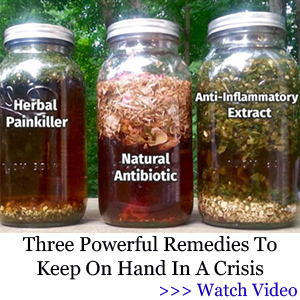 Activated Charcoal for Naturally Healing Wounds
Activated Charcoal for Naturally Healing Wounds
Why You Should Put Garlic in Your Ear Before Going to Sleep (Video)









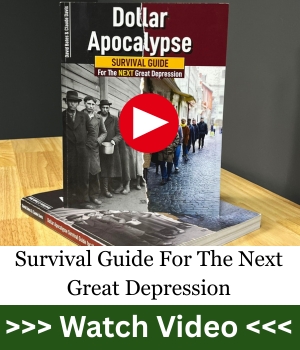
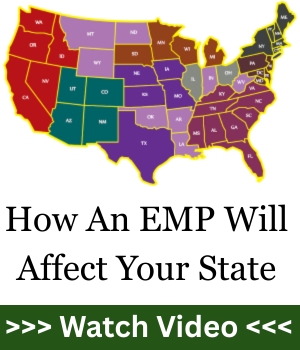
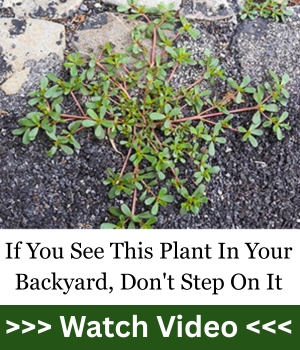
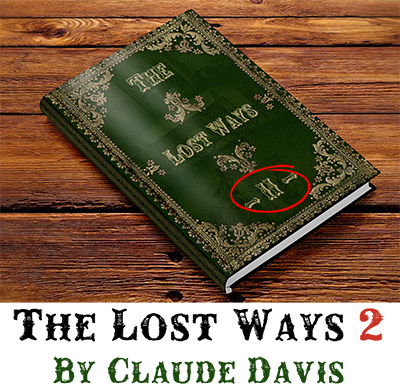









Say goodbye to counterfeit drugs. Acute Pharmacy only sources from licensed pharmaceutical companies.